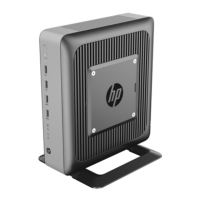Installing SODIMMs
CAUTION: You must disconnect the AC power cord and wait approximately 30 seconds for the power to drain
before adding or removing memory modules. Regardless of the power-on state, voltage is always supplied to
the memory modules as long as the thin client is plugged into an active AC outlet. Adding or removing
memory modules while voltage is present may cause irreparable damage to the memory modules or system
board.
The memory module sockets have gold-plated metal contacts. When upgrading the memory, it is important
to use memory modules with gold-plated metal contacts to prevent corrosion and/or oxidation resulting from
having incompatible metals in contact with each other.
Static electricity can damage the electronic components of the thin client or optional cards. Before beginning
the following procedures, be sure that you are discharged of static electricity by
briey touching a grounded
metal object.
When handling a memory module, be careful not to touch any of the contacts. Doing so may damage the
module.
1. Remove/disengage any security devices that prohibit opening the thin client.
2. Remove all removable media, such as USB ash drives, from the thin client.
3. Turn o the thin client properly through the operating system, and then turn o any external devices.
4. Disconnect the AC power cord from the AC outlet, and disconnect any external devices.
CAUTION: You must disconnect the AC power cord and wait approximately 30 seconds for the power to
drain before adding or removing memory modules. Regardless of the power-on state, voltage is always
supplied to the memory modules as long as the thin client is plugged into an active AC outlet. Adding or
removing memory modules while voltage is present may cause irreparable damage to the memory
modules or system board.
5. Remove the stand from the thin client.
6. Lay the unit at on a stable surface with the right side up.
7. Remove the thin client access panel. See Removing and replacing the access panel on page 5.
WARNING! To reduce risk of personal injury from hot surfaces, allow the internal system components
to cool before you touch them.
8. Locate the memory compartment on the system board. See Locating internal components on page 8.
9. If a PCIe card is installed, remove it.
10. Loosen the two captive screws (1) securing the memory compartment cover.
Installing additional SDRAM system memory 19

